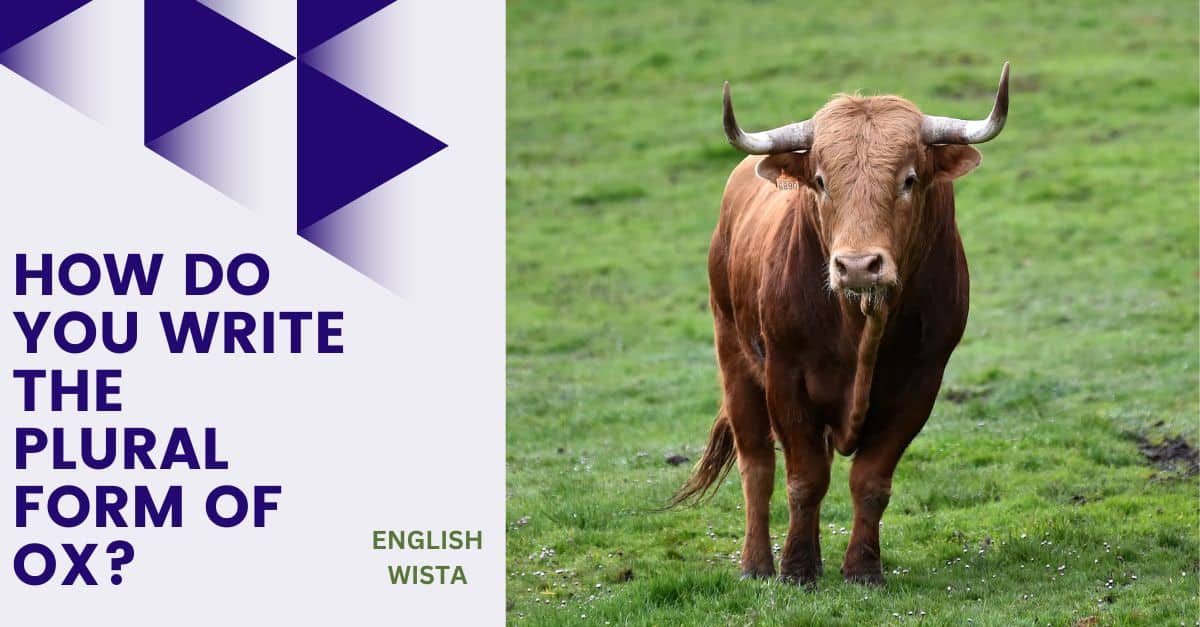Have you ever come across the word “ox” and wondered how to make it plural? You’re not alone! English can be tricky, especially when it comes to irregular plurals. While most nouns follow the simple rule of adding “-s” or “-es” to form their plurals, some words have their own unique patterns. “Ox” is one of them, and its plural form might surprise you. Let’s dive in and make this crystal clear, so you’ll never have to second-guess again.
What Is the Plural of “Ox”?
The plural form of “ox” is “oxen.” Yes, instead of the usual “oxes,” we use “oxen.” This might sound a bit strange if you’re more familiar with regular plurals, but don’t worry — it’s just one of those quirks of the English language. Words like “oxen” are remnants of older forms of English, which we’ll explore later.
Here’s a quick example:
- Singular: The ox is grazing in the field.
- Plural: The oxen are grazing in the field.
Why Isn’t It “Oxes”?
That’s a great question! Most nouns in English become plural by adding “-s” or “-es,” like “dog” (dogs) or “box” (boxes). However, “ox” belongs to a small group of irregular nouns that form their plurals differently. This group includes words like “child” (children) and “goose” (geese). Instead of following the usual rule, these words stick to older pluralization patterns from Old English.
In Old English, many nouns formed their plurals with “-en” instead of “-s.” Over time, most of these patterns disappeared, but a few words — like “ox” — held onto the tradition. That’s why we say “oxen” today.
Fun Fact: What’s the Origin of the Word “Ox”?
The word “ox” comes from the Old English word “oxa,” which referred to a domesticated bovine animal often used for plowing fields or pulling carts. Back then, the plural form was “oxan,” which eventually evolved into “oxen” in modern English. This linguistic history explains why “oxen” feels a bit old-fashioned compared to regular plurals.
Is “Ox” Singular or Plural?
“Ox” is singular. If you’re talking about just one animal, you use “ox.”
- Example: The ox is a strong animal.
When you’re referring to more than one, that’s when you switch to “oxen.”
- Example: The oxen were used to pull the heavy cart.
It’s similar to how “man” and “men” work: one man, but many men.
Are There Other Words Like “Oxen”?
Yes, but they’re quite rare. Some other examples of irregular plurals include:
- Child → Children
- Goose → Geese
- Mouse → Mice
These words, like “oxen,” follow older pluralization rules that have stuck around. They’re exceptions to the standard “-s” and “-es” rule, so it’s worth memorizing them.
Real-Life Examples of “Oxen”
Let’s see “oxen” in action with a few practical examples:
- The farmer relies on his oxen to plow the fields every spring.
- In the parade, a pair of decorated oxen pulled a traditional wooden cart.
- Oxen have been used as draft animals for thousands of years.
- The children were excited to see a group of oxen at the petting zoo.
Notice how “oxen” is always used when referring to more than one ox.
Collective Nouns for Oxen
Did you know that animals often have special collective nouns? For oxen, the collective noun is “a team of oxen.”
Here’s an example:
- The team of oxen worked together to pull the wagon.
Other animal examples include:
- A flock of birds
- A herd of cows
- A pack of wolves
These terms make it easy to describe groups of animals in a fun and specific way.
How Can You Remember “Oxen”?
If you’re worried about forgetting, here are a few tips:
- Think of “children.” Just like “child” becomes “children,” “ox” becomes “oxen.”
- Use it in a sentence. Practice saying or writing sentences like: “The oxen are grazing in the field.”
- Make it a fun rhyme. Try saying: “One ox, two oxen — that’s the plural solution!”
The more you practice, the easier it will become.
Fun Fact: Oxen in History
Oxen have been vital to human civilization for thousands of years. They were some of the earliest animals domesticated for agricultural work. Farmers used them to plow fields, pull carts, and even transport goods. Their strength and endurance made them indispensable before the invention of modern machinery. Even today, in some parts of the world, oxen are still used for farming and transportation.
Common Questions About “Ox” and “Oxen”
1. Can I Say “Oxes”?
No, “oxes” is not correct. The only correct plural form is “oxen.”
2. Is “Oxen” Still Used Today?
Yes! While you might not hear it every day, “oxen” is still used, especially in farming or historical contexts.
3. What’s the Difference Between “Ox” and “Cow”?
An “ox” is typically a domesticated male bovine trained for work, while “cow” refers to a female bovine, usually kept for milk production. Not all male bovines are oxen; they’re specially trained for tasks like pulling carts or plows.
4. Are Oxen the Same as Bulls?
No. Bulls are male bovines that are not castrated and are often used for breeding. Oxen, on the other hand, are usually castrated males trained for work.
Conclusion
So, there you have it! The plural form of “ox” is “oxen,” not “oxes.” While it might seem unusual, it’s a fascinating reminder of English’s rich and complex history. Next time you hear someone mention oxen, you’ll know exactly why the word works the way it does.
To sum up:
- Singular: Ox
- Plural: Oxen
Keep practicing, and soon this will feel as natural as “child” and “children.” Who knew grammar could be this much fun? Now go impress your friends with your newfound knowledge!


